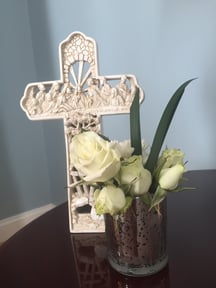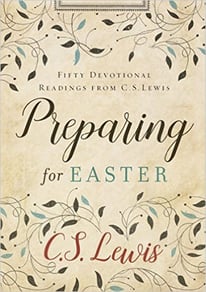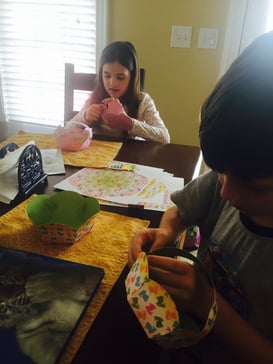What is your favorite family tradition? What Thanksgiving dish makes your children’s eyes sparkle with a unique joy? The traditions we create bond our families together through the special rituals – “it’s what we do.”
The goal is to strengthen our relationships and build lasting meaning into the most important parts of our lives. Holiday traditions are often instructional in nature, providing imagery to reinforce the sacred and significant of the holiday.
A nativity scene in the living room provides a parent with opportunity to discuss the miracle of Christmas. Even as your children grow older, the same symbolic feature is a wordless reminder of the true reason for the season. 
The stories told, the songs sung, and even the food prepared are rich with symbolism that points back to Christ. Thankfully for us, the story did not end with the Wise Men and Shepherds.
As we approach Easter, here are three simple ways to incorporate traditions and meaning into your Easter celebrations.
1. Decorate!
Decorations provide symbolism for the season and are quiet reminders of why this time of year is so special. 
In the rush of the morning routine, the Easter decorations can refocus our hearts that there is more to this life than just the daily grind. A treasured family symbol of Easter is also a good conversation starter.
Enlist your children in the decorating process. However, it is a good idea to have a few non-breakable items for little hands to place around the house. Your visions of a Norman Rockwell moment with your kids can quickly turn into sweeping up the shards of your great grandmother’s dishes.
Whether it is plastic eggs or grandma’s dishes, as the years go on these family decorations increase in meaning and provide continuity for your children.
2. Read with your children.
Research regarding the importance of reading with your children is overwhelming. When the day is done and small children are ready for bed, it is an ideal opportunity to be close as you read a book with them. The habit of reading together is proven to improve literacy and cognition, and it is also an incredible bonding experience for the parent and child.
Collect a handful of Easter books to read throughout the season. Each year bring these books out and even add to the collection to read again and again. 
For older children, a quick devotional around the dinner table is another important way to realign your child’s worldview. After a busy day of academics and extra-curricular activities, the devotional provides a great opportunity to learn how to apply biblical principles to daily interactions.
In order to get the most out of your devotion time, be mindful of your child’s age. Readings that are steeped in theological prose may be inspirational to you, but your third grader may struggle to comprehend the language and consequently struggle to pay attention.
Be economical in your reading. Portion control is key! Oftentimes, the longer we speak, the less impact we have with our words.
Share something clear, true, uplifting and brief. If your children are not talkative or engaging, that is okay. Often we want confirmation that our kids have heard us, but try to resist a forced dialogue. Instead, allow the topic to germinate in their hearts.
Great books to help create a meaningful Easter are:
For small children
- God Gave Us Easter by Lisa Tawn Bergren and Laura J. Bryant
- What is Easter? by Michelle Medlock Adams and Amy Wummer
- Easter Stories and Prayers by Kathleen Long Bostrom and Elena Kucharik
For older children
- Preparing for Easter by C.S. Lewis
- Walk with Jesus: A Journey to the Cross and Beyond by Charles Swindoll
- The Gift of Easter: 14 Days of Devotions from Zondervan
3. Get Hands-on Creative.
There is a reason why we decorate Easter eggs. Traditionally, when early Christians in Rome abstained from meat, this also included eggs. However, the hens kept laying eggs. Because of this, eggs were decorated and given as gifts during this time of year.
The egg is also a symbol of life and rebirth, which represents Jesus, his life and resurrection that promised eternal life through faith in him (John 11:25).
Decorating eggs can be as simple or as elaborate as the ages and skills can handle. Whether it is a kit from the grocery store or a Pinterest design that could pass for Fabergé, the purpose is to celebrate the season together.
In Greek Orthodox homes, eggs are dyed red and later eaten on Easter Sunday. The beautiful rich color is symbolic of the blood of Christ. To obtain the beautiful deep red color on the eggs, use yellow onions. You can find a recipe for Red Egg Dye here.
There are also many websites that can inspire you with fun craft ideas. But if spending hours crafting Easter scenes out of egg cartons is not your gift, do not fret. Old wrapping paper or cardstock can inspire your child to create something handmade to your Easter celebration.
If a complicated art project adds more pressure than pleasure to the day, a simple coloring sheet can keep little hands busy and little hearts attuned to the season. A useful site for ideas and printable sheets is Apples4theTeach.com.
Comment below and share your favorite decorations, books, creative activities or traditions.
Next Week: Make Easter Meaningful, Part II: Let’s Eat!


.png?width=1920&name=VCA%20VA%20Logo%20White%20PNG%20(1).png)